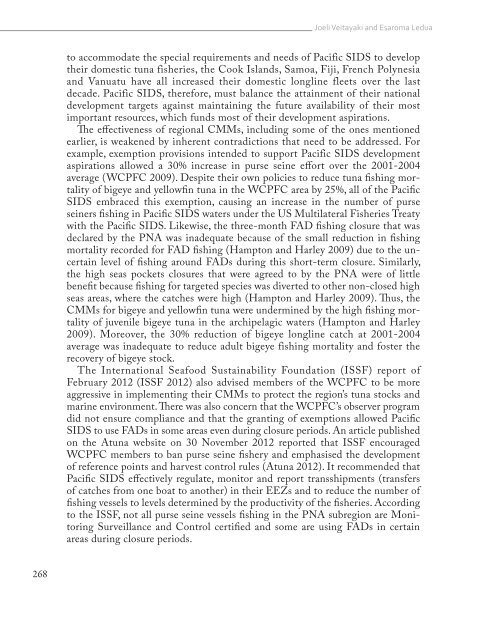Fisheries in the Pacific
Fisheries_in_the_Pacific
Fisheries_in_the_Pacific
Create successful ePaper yourself
Turn your PDF publications into a flip-book with our unique Google optimized e-Paper software.
Joeli Veitayaki and Esaroma Ledua<br />
to accommodate <strong>the</strong> special requirements and needs of <strong>Pacific</strong> SIDS to develop<br />
<strong>the</strong>ir domestic tuna fisheries, <strong>the</strong> Cook Islands, Samoa, Fiji, French Polynesia<br />
and Vanuatu have all <strong>in</strong>creased <strong>the</strong>ir domestic longl<strong>in</strong>e fleets over <strong>the</strong> last<br />
decade. <strong>Pacific</strong> SIDS, <strong>the</strong>refore, must balance <strong>the</strong> atta<strong>in</strong>ment of <strong>the</strong>ir national<br />
development targets aga<strong>in</strong>st ma<strong>in</strong>ta<strong>in</strong><strong>in</strong>g <strong>the</strong> future availability of <strong>the</strong>ir most<br />
important resources, which funds most of <strong>the</strong>ir development aspirations.<br />
The effectiveness of regional CMMs, <strong>in</strong>clud<strong>in</strong>g some of <strong>the</strong> ones mentioned<br />
earlier, is weakened by <strong>in</strong>herent contradictions that need to be addressed. For<br />
example, exemption provisions <strong>in</strong>tended to support <strong>Pacific</strong> SIDS development<br />
aspirations allowed a 30% <strong>in</strong>crease <strong>in</strong> purse se<strong>in</strong>e effort over <strong>the</strong> 2001-2004<br />
average (WCPFC 2009). Despite <strong>the</strong>ir own policies to reduce tuna fish<strong>in</strong>g mortality<br />
of bigeye and yellowf<strong>in</strong> tuna <strong>in</strong> <strong>the</strong> WCPFC area by 25%, all of <strong>the</strong> <strong>Pacific</strong><br />
SIDS embraced this exemption, caus<strong>in</strong>g an <strong>in</strong>crease <strong>in</strong> <strong>the</strong> number of purse<br />
se<strong>in</strong>ers fish<strong>in</strong>g <strong>in</strong> <strong>Pacific</strong> SIDS waters under <strong>the</strong> US Multilateral <strong>Fisheries</strong> Treaty<br />
with <strong>the</strong> <strong>Pacific</strong> SIDS. Likewise, <strong>the</strong> three-month FAD fish<strong>in</strong>g closure that was<br />
declared by <strong>the</strong> PNA was <strong>in</strong>adequate because of <strong>the</strong> small reduction <strong>in</strong> fish<strong>in</strong>g<br />
mortality recorded for FAD fish<strong>in</strong>g (Hampton and Harley 2009) due to <strong>the</strong> uncerta<strong>in</strong><br />
level of fish<strong>in</strong>g around FADs dur<strong>in</strong>g this short-term closure. Similarly,<br />
<strong>the</strong> high seas pockets closures that were agreed to by <strong>the</strong> PNA were of little<br />
benefit because fish<strong>in</strong>g for targeted species was diverted to o<strong>the</strong>r non-closed high<br />
seas areas, where <strong>the</strong> catches were high (Hampton and Harley 2009). Thus, <strong>the</strong><br />
CMMs for bigeye and yellowf<strong>in</strong> tuna were underm<strong>in</strong>ed by <strong>the</strong> high fish<strong>in</strong>g mortality<br />
of juvenile bigeye tuna <strong>in</strong> <strong>the</strong> archipelagic waters (Hampton and Harley<br />
2009). Moreover, <strong>the</strong> 30% reduction of bigeye longl<strong>in</strong>e catch at 2001-2004<br />
average was <strong>in</strong>adequate to reduce adult bigeye fish<strong>in</strong>g mortality and foster <strong>the</strong><br />
recovery of bigeye stock.<br />
The International Seafood Susta<strong>in</strong>ability Foundation (ISSF) report of<br />
February 2012 (ISSF 2012) also advised members of <strong>the</strong> WCPFC to be more<br />
aggressive <strong>in</strong> implement<strong>in</strong>g <strong>the</strong>ir CMMs to protect <strong>the</strong> region’s tuna stocks and<br />
mar<strong>in</strong>e environment. There was also concern that <strong>the</strong> WCPFC’s observer program<br />
did not ensure compliance and that <strong>the</strong> grant<strong>in</strong>g of exemptions allowed <strong>Pacific</strong><br />
SIDS to use FADs <strong>in</strong> some areas even dur<strong>in</strong>g closure periods. An article published<br />
on <strong>the</strong> Atuna website on 30 November 2012 reported that ISSF encouraged<br />
WCPFC members to ban purse se<strong>in</strong>e fishery and emphasised <strong>the</strong> development<br />
of reference po<strong>in</strong>ts and harvest control rules (Atuna 2012). It recommended that<br />
<strong>Pacific</strong> SIDS effectively regulate, monitor and report transshipments (transfers<br />
of catches from one boat to ano<strong>the</strong>r) <strong>in</strong> <strong>the</strong>ir EEZs and to reduce <strong>the</strong> number of<br />
fish<strong>in</strong>g vessels to levels determ<strong>in</strong>ed by <strong>the</strong> productivity of <strong>the</strong> fisheries. Accord<strong>in</strong>g<br />
to <strong>the</strong> ISSF, not all purse se<strong>in</strong>e vessels fish<strong>in</strong>g <strong>in</strong> <strong>the</strong> PNA subregion are Monitor<strong>in</strong>g<br />
Surveillance and Control certified and some are us<strong>in</strong>g FADs <strong>in</strong> certa<strong>in</strong><br />
areas dur<strong>in</strong>g closure periods.<br />
268


